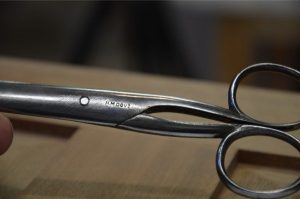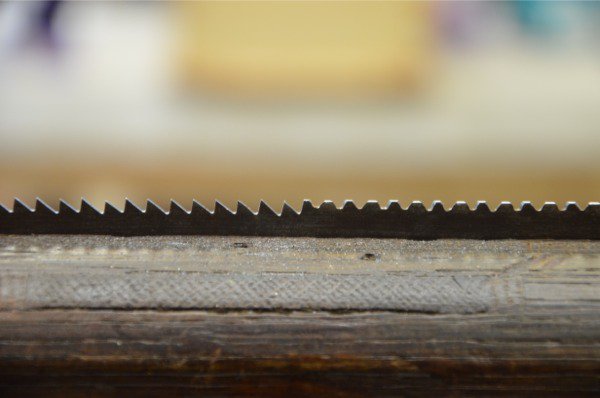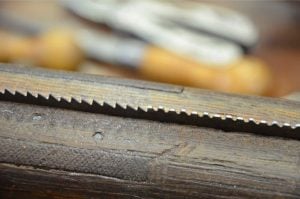The Real Cost of Living
The price of buying cheap is a costly experience in lost skill
I looked through the kitchen stuff at the flea market for knives and scissors, wondering what kind of a culture abandoned old scissors like these in favour of new ones with plastic handles and other poor design features and it dawned on me. 

The scissors I bought were the very best. I mean superbly made and wonderful to use. One pair, the ones I liked the most, were made for her majesty’s government. They were nicely designed, individually shaped and handmade. I kept them for my own use in the shop but I do share.
If you were to ask most woodworkers what they lament the most it would most likely be not knowing how to sharpen and use hand tools properly. I mean, sharpening a cutting edge to a plane or chisel, or filing a handsaw to task. These are things we could still be using.
Now I looked at the saw as I filed the teeth to shape and asked myself just how could a saw get this dull. What brute of a man could pull and push a saw like this through wood to get it into such a condition. I started laughing. I laughed so hard my sides split and my sanity returned as I filed and shaped the teeth. Then I asked the question of Phil and John, in a reconditioning of my own composure, for it seemed to me that to get a saw into that condition it would take a man, even a brute of a man, a mindless man, about 100 hours of continuous work to so damage the teeth of this saw. I mean, thinking this thing through for even a minute, it must not have cut any wood for 75 of those hours. I think a man could have said to himself something is wrong here. I mean as he pulled and pushed the saw. Surely he must at some point have said to himself I f I learned to sharpen this saw it would surely only take me an hour to learn. Why, if I bought a saw file I could sharpen it myself and it would save me hours of labouring. In one more hour I could actually sharpen this saw myself, that would save me 98 hours of hard labour.

You see, when we forget the simple things, we can no longer pass them on. The chisels become can openers and tools for chipping concrete with. When we buy disposables we lose our potency. When sandpaper replaces the cutting edge and plastic faced pressed fibreboard replaces wood, reality and skilled work is deemed an excess and we end up mindlessly buying from The Bigger Box companies like IKEA and Wallyworld and many a dozen others, comforting ourselves that what we bought was really cheap without realising that we no longer have anything to pass on that has much of any worth. Can I pass on a pair of a plastic handled scissors or a Bhaco hard point saw? When I begin to see I have nothing to pass on, I begin to see things may have really cost me much more than I ever thought. It may have cost me everything if I no longer have anything to pass on. Not even skill.


I am glad you could look at the funny side with the saw, a friend of mine when we were much younger, about 14 or so, presented an electric drill to my father and stated that his family had a devil of a time in using it. Dad looked at it and flicked the forward /reverse switch to forward and handed it back. This drill had been used to construct an entire pergola apparently, running in reverse the whole time. We still have a good laugh about it.
Sounds like a quick scissor sharpening video is in order! 😀
Well said good Sir!
Thanks so much for your words.
I happen to find an old pair of scissors in my garage 2 weeks ago. It was in a box of maps I collected from my car when I sold it over 5 years ago.
And I thought to myself. If I can sharpen chisels and planes (Paul Sellers method), then I can probably bring these back to life.
So I took them into my work area and after about 30 minutes I had a brand newly-used pair of scissors for the shop.
They reminded me of my mom’s pair which she always had in her bag, (she was a seamstress). Hers were always sharp, they had to be as she was paid by the number of pieces she sewed each day. She still has those scissors.
Marilyn
I agree! Video!
We are doing one and will post it on YT when done.
Your saw story reminded me of a saw I got a week ago from a garage sale for $2. It was a Disston #7 with an etch still hiding under a light coat of red rust but the plate was so concave in the middle that when placed on a flat bench, the middle is 1/2 inch higher then the ends! It had been sharpened (?) this way. I wondered what sort of person had done that. It can’t have cut well and looked awful to the naked eye. I plan to bring it back to life, re-toothing it, but I need to get a little better myself before trying that.
Your blog today really resonated with me.
I second that! Would love to see a video on that. Maybe kitchen knives???? 😉
Excellent blog,…I thought I was one of the few who appreciates old scissors, ..thankfully proved wrong. I have many and my favorite is my father’s very large pattern maker’s shears. Still as sharp as when new, cuts better than anything modern with plastic handles for sure. It will be passed on.
I have mastered the convex bevel sharpening method for my chisels (Thank you Paul for revealing the simplicity and common sense of this). The modern six inch grinding wheel sure made a mess of our thinking on this subject.
Crosscut saw sharpening is still a work in progress. I have been working with old worn files and the results are decent but not satisfactory. Time to invest in new files to achieve proper uniformity. Please continue to blog on these necessary skills.
Well, to me the sawteeth look like the previous owner hit a grasped nail, wondering why there is no progress bevore realizing. 😉 (happened to me,too…)
I’ve already resharpened one (disposable) scissor.
Well, it cuts better now, but it is far from perfection, so I’m looking forward for your video!
The bright spots you see on the saw are where I had to file the teeth down with a flat file to get them level. I can tell you that this sawyer would have been using the saw dull for several years to get it into that condition, unless they used it for stone cutting.
…appearances are deceptive sometimes…:-)
Excellent post. I too rescued a similar saw — except the teeth were even more worn down ! — and I too marveled at the amount of effort exerted by some hapless user to wear it down that way. It’s now ferociously sharp. A good portion of my shop is populated with rescued and repaired castoffs which match or exceed in quality most of what’s available today.
Well, I think we should reflect on what we have already learned about sharpening chisels, planes, an saws, and think about the concepts as applied to scissors. Once the video comes out it we will learn even more having tried on our own. I have sharpened scissors to where they cut wonderfully but am also sure I have much more to learn, and I look forward to the video.
Excellent post. My theory having survived GSCE’s many years ago is that the saw was probably donated to a school where it was used to cut plywood and chipboard for several years.
And I agree on the loss of skills. We replace skills with money and machines and this makes us less able to react to things and create, it also wears down our independence and we end up being machines, little shadows serving a conveyor belt in the hope we save enough to retire early and do what we want. I see many fellow apprentices doing selling their freedom for this phantom promise every day.
Paul, you are spot on. Arguably, The throw away mentality has transcended to other aspects of our culture. Profit before quality, quantity over real craftsmen ship, hurry, hurry ,hurry, buy , buy, buy. Not holding up? Throw it away and get another one!
Hello, Paul and all other brothers and maybe sisters who love quality in life, I seem to have had thrust at me though my life umpteen old saws;I love em;I was blessed with having served an apprenticeship with a very old fashioned firm of joiners, we only had two machines a planer and a very aged bandsaw all other work was performed by hand and we worked a 51/2 day week Sat the foremans job was to sharpen all moulding planes used during the week(there were hundreds) of em, we all got to know each other very well because lacking machinery hand work was fairly silent and we chatted most of the day (less dust too) I will never forget the men I worked with they were fine people not perfect by any means but just fine well balanced people not rich not poor either I could write so much more about those days but I hate typing,BUT I love saws I think I have some 18th cent saws wafer thin and a joy to me